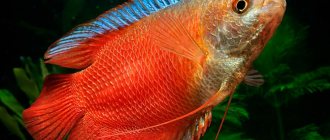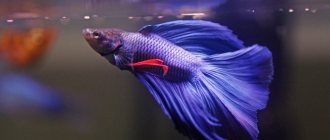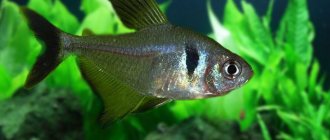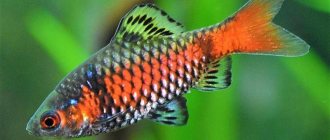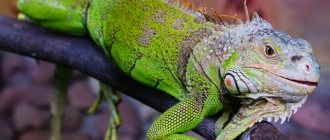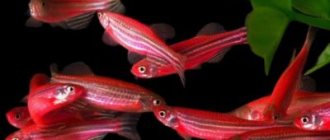Habitat
The largest population of common piranhas (this is their official name) lives in the Amazon River, Parana, Orinoco, Essequibo, in America.
Piranhas prefer warm countries (South America) and can be found in Colombia, Uruguay, Brazil, Bolivia, Argentina, Peru, Ecuador, Paraguay and Venezuela.
This monster, like guppy fish , is a freshwater fish, and therefore residents of coastal areas can rest assured that these fish are not found in salt water.
But flocks of 20 - 30 individuals can be seen in rivers and lakes, tributaries and ponds, and even on flooded areas of land.
Important! Recently, it has become fashionable to breed predatory fish, in particular piranhas, at home. But some careless aquarists get bored with fish. And they release them to free bread. Therefore, even in our climate zone they can be found in reservoirs. This is evidenced by confirmed stories from victims of piranhas.
Aquarium piranhas are refined individuals, that is, not adapted to wild life, as they were bred in captivity. The owner of the aquarium only with some caution reaches into the aquarium with his hands to clean it or fix the interior
Why is it dangerous?
For many people, it becomes a discovery that the predator living in rivers is practically not dangerous to humans, but is afraid of them. On the Internet you can find stories in which people swam without problems next to a large number of piranhas and did not become edible prey for these “killers”.
Biologist Herbert Axeldorf conducted an interesting experiment - he released fifty predators into the pool, and then climbed inside himself. Piranhas did not show any aggression, so the scientist decided to expand the experiment, for which he picked up a small piece of meat and began to swim with it in his hands. The fish did not show aggression towards the biologist. After Herbert climbed out of the pool and threw meat to the predators, they immediately pounced on him and devoured him.
Piranhas are the heroes of several horror films, serving as the main villains of the films. In fact, there is no information about human deaths due to fish attacks. There were small attacks, as a result of which the fish bit a person. The reason lay in weather conditions when rivers dry up and predators attack each other. In this case, in addition to the piranhas, random people may also suffer because of the attacks. Sometimes aggressiveness increases during spawning, but this does not happen often. Massive fish attacks on people do not occur.
Sea predators are not aggressive creatures, but very timid and do not attack animals that are larger than them. The flock way of life is determined by the increased safety of the individual and the entire flock. The number of enemies in their natural habitat is enormous. The fish have no problem defeating smaller fish, tearing them apart.
Characteristic
Piranhas are famous for their jaws; photos of the fish will be shown when the jaw approaches; they are armed with very sharp teeth in the form of plates.
Such teeth can easily tear out a piece of meat, bite off a finger and even bite through steel. But this concerns wild fish.
Aquarium piranhas, like axolotls , are refined individuals, that is, not adapted to wild life, since they were bred in captivity.
The owner of the aquarium only with some caution reaches into the aquarium with his hands to clean it or fix the interior.
Important! Be careful! When working in an aquarium with piranhas, do not push them into a corner. Otherwise, the fish will have to attack and use its teeth. Therefore, you need to replant the fish during cleaning not with your hands, but with the help of a net.
Both wild and aquarium piranhas are cowardly fish.
First, out of shock, they turn over on their side and turn pale, pretending to be dead and sinking to the bottom.
Then, having recovered, they can attack, and then the one who disturbed them will be in trouble.
Piranhas reach only 20 cm in length (red-bellied piranhas can also be 33 cm long). The largest representative of the species seen in wild waters was 48 cm long
Health, disease and prevention
The main health problems for piranhas, like other aquarium fish, arise due to improper keeping conditions - bad water, a cramped aquarium and an aggressive neighborhood. Piranha is distinguished by active regeneration of the skin and fins. If damaged, they are able to recover well.
Alarming symptoms include decreased fish activity, disruption of their cover, ulcers, and refusal to feed. In this case, the first thing to do is check the water temperature and its composition - for NH4, NO2, NO3. If the indicators are too high, bring them back to normal, check and clean the filters, increase the aeration of the water, and replace some of the water with fresh water.
Sources
- https://vplate.ru/akvariumnye-rybki/vidy/pirani/
- https://fanfishka.ru/akvariumnye-stati/501-piraniya.html
- https://moj-akvarium.ru/rybki/pirani-v-akvariume
- https://simple-fauna.ru/pets/exotic-pets/soderzhanie-pirani/
- https://MrHvost.com/ryba-piranya
- https://chemkormit.ru/food/rybki/kak-pravilno-podobrat-korm-dlya-piraniy/
- https://aquarium-fish-home.ru/akvariumnye-rybki/piranya-v-akvariume-soderzhanie-sovmestimost-video-fotoopisanie/.html
[collapse]
Appearance
What does piranha fish look like? The photo will show a laterally flattened fish with a dense body and a powerful tail.
It is the tail that helps develop speed and maneuverability during an attack.
- The length of the fish reaches only 20 cm (red-bellied piranhas are also found at 33 cm). The largest specimen seen in wild waters was 48 cm long.
- The weight of one fish is from 500 grams to a kilogram.
- The color of the young is pale, light gray.
- Piranhas change color as they age. Females turn purple, males become bright silver, blue-black, bright red or silver with an olive tint.
- Mature red-bellied piranhas are very beautiful: their throat, belly and rear lower fin are bright red, and they themselves are silver-steel.
The color of young piranhas is pale, light gray. As fish age, their color changes. Females turn purple, males become bright silver, blue-black, bright red or silver with an olive tint.
What does it look like
By appearance (in person or in photographs), the fish is quite easy to distinguish from representatives of other species; it looks recognizable. It has an oval-shaped body that is flattened at the sides. The fins are long, there is a wide tail, and there are large eyes on the head. The color of the scales directly depends on the species to which the predator belongs, as well as its diet. The most common colors are green and blue. The body length is not very long - about 30 centimeters, sometimes there are individuals with a length of up to 100 centimeters. The fish has gray scales on the sides and reddish scales on the bottom. At the end of the tail there is a black line. Young individuals have dark spots on the sides of the body, which disappear as they grow older.
Photos of the sea predator are very recognizable due to its jaws, which are not found in any living organism. The size of the teeth (triangular shape) is half a centimeter, slightly curved inward, and are extremely sharp. During the hunt, they attack their prey and immediately tear it into pieces or cut off the flesh.
Thanks to their developed jaws, they can bite through small bones. The unusual jaw, when the upper and lower teeth meet, creates enormous pressure with a force of 320 newtons, comparable in strength to traps installed to capture wild animals. It rarely occurs to humans, but it is strong enough to bite off a finger. Local residents living on the mainland of South America use piranhas instead of household appliances - they are used to shave or use them instead of scissors, they often use predators to prepare a variety of dishes - the fish is edible.
Not every fish can boast of a perfect bite, but this does not hinder it at all. Teeth displaced relative to each other grind flesh, break bones and tear veins. This strength comes from developed muscles and powerful tendons, which together create enormous pressure. In carnivorous species, the main force is located in the upper and middle parts of the teeth, while in herbivores it is evenly distributed over the entire surface of the jaw.
Piranhas are feared not because of their killer appearance, but because of their gluttony. A book by zoologist Alfred Brehm describes a story about a crocodile that is much larger than its rivals, but it fled from them. Marine predators also have their opponents, who are found in their usual habitat (rivers and other bodies of water) - dolphins and caimans.
Few people know that piranhas can make sounds. They sound like a dog barking while jumping out of the water. Mainlanders say that the sounds made during feeding are similar to the sound of drums. When communicating with fellow animals, they prefer to “croak.”
Key Features
The most remarkable and dangerous thing about the piranha is its teeth, located in its large mouth.
Seeing her jaws - massive, protruding, you immediately want to recoil, since such a muzzle does not evoke sympathy.
The teeth are triangular, up to 5 mm long, the lower jaw is larger than the upper.
A piranha bite is dangerous: the jaws close so that the upper teeth exactly fit into the voids between the teeth of the lower jaw.
Important! Do not stick your fingers into the mouths of unfamiliar fish that live in both our and American reservoirs.
Piranhas are the orderlies of reservoirs (like wolves are the orderlies of the forest), since they do not hesitate to eat carrion, they support the principle of natural selection: they eat the weak and sick
Content
Piranha is an expensive fish; most species require high-quality live food, expensive equipment and a huge aquarium. Not recommended for beginners.
Aquarium
Each individual accounts for at least 120 liters. Place a small group of 4 individuals in a 500-liter aquarium. A school of fish will require a gigantic aquarium with a volume of thousands of liters.
Water parameters
| Temperature | 22–27 degrees |
| Acidity | 6,5–7 |
| Rigidity | 4–15 dGh |
| Water movement | weak or moderate |
It is necessary to maintain a comfortable temperature in the aquarium and monitor the cleanliness of the water. The liquid should not be cold or too warm. The feeding method of predators implies rapid water pollution. Some aquarists change 30–50% of the liquid weekly, others change 10–15% of the total water volume.
Plants
Under natural conditions, the piranha biotope is full of dense vegetation. Fish in an aquarium can damage plants. Place greens that don't require a lot of light:
- Java moss;
- ferns;
- Anubias;
- blue.
Shelters
Provide plenty of hiding places to make timid predators feel comfortable. Leave room for free swimming. Piranhas love shelter in the form of:
- plants;
- caves;
- grottos;
- driftwood
Priming
Place sand or fine gravel at the bottom.
Siphon the soil at least once a week, thoroughly cleaning the entire bottom.
Equipment
Equip your aquarium:
- Filter. Large capacity will require multiple devices. Give preference to an external filter.
- Compressor. The device will provide oxygen saturation of the water.
- Thermometer and heater. Monitor the temperature in the aquarium and maintain it at a level that is comfortable for your pets. In hot weather, a cooler or ice containers placed in water will help cool the water.
Lighting
Choose moderate lighting that suits plants and fish. Too much light causes stress for piranhas. To prevent the appearance of algae, select light in the blue and red spectrum, excluding yellow. Do not allow sunlight to hit the walls of the aquarium. Place the tank at least 1.5 meters from the window. Make sure that the lamp does not overheat the liquid.
Nutrition
Piranhas gather in large schools, and therefore the prey usually does not leave them alive.
Prowling through bodies of water, they eat everything living and moving.
Everything that can be snacked, chewed and swallowed goes into their food:
- plants;
- fish;
- invertebrates;
- snails;
- amphibians.
They hunt in muddy water, so it’s easier for them to swim to the prey in a flock. They love to hide in snags, pebbles, and bury themselves in mud.
Even large animals are among their victims: horses, buffalos, capybaras, birds - they are able to gnaw them in a minute.
And if they smell blood, they have no equal in speed, cruelty and frequency of jaw action. It turns out that the films are based on real events.
Interesting! Do you know who piranhas are afraid of? Amazonian dolphins, caimans, reptiles (anacondas, not pythons )! They all eat piranhas if they get in their way.
We can conclude that since piranhas are so dangerous, it is easier to exterminate them than to accept their existence. But this is wrong.
Firstly, these fish are the orderlies of reservoirs (like wolves are the orderlies of the forest), since they do not hesitate to eat carrion, they support the principle of natural selection: they eat the weak and sick.
And secondly, in Brazil they were poisoned once before, but the result surprised everyone.
The piranhas remained safe and angry, as other aquatic inhabitants disappeared, poisoned by poisons.
Piranhas go to spawn in spring and until mid-summer. Female fish lay their eggs on the bottom, mainly closer to the roots of plants, in the silt, digging holes. There can be 50,000 eggs at a time
Subfamily Catoprionines
This subfamily is represented by only one species - the flag piranha. The fish are quite harmless and lead a semi-parasitic lifestyle, their main food is the scales of other fish, although the appearance of these aquatic inhabitants is quite ominous, and they are not inferior in severity to their carnivorous counterparts. The shape of the flag piranha is diamond-shaped, flattened on the sides. The color of the scales is gray-green with a silvery sheen. A distinctive feature is the presence of a red spot on the gill covers. The outer rays of the anal and dorsal fin are strongly elongated, and the caudal fin has a black root. The sizes are small, only 10-15 cm.
This fish, similar to the common piranha and being its closest relative, mainly has plant foods (60%) in its diet, and only 40% consists of small fish. But it still needs to be kept separately from other fish, otherwise very small ones will be eaten, and large ones risk being left with damaged fins and partially without scales. As animal food, you can use small shrimp or fish, earthworms, and plant food - spinach leaves, lettuce, nettles and other greens.
Reproduction. Spawning
At the 10th month of life, the female is already able to lay eggs.
If piranhas are very large, then they can enter the period of maturity in the second, third, or even fifth year of life.
Piranhas go to spawn in spring and until mid-summer. Female fish lay their eggs on the bottom, mainly closer to the roots of plants, in the silt, digging holes.
There may be, it’s scary to think, 50,000 eggs at a time. The eggs are large and can reach a size of 4 mm.
After a week, the embryos are already feeding on themselves, passing water with microorganisms through themselves. And after two weeks the fry appear.
Parents, protecting their offspring, circle around all the time, driving away and eating enemies.
Interesting! The fry are initially herbivorous, feeding on plankton; as they grow older, they switch to zooplankton and then to small fish.
One piranha requires an aquarium with a volume of at least 100 liters. Accordingly, for four fish - from 300 liters or more. It is imperative to place any objects in the aquarium in which these fish can hide.
Black piranha
This is another species from the Serrasalmina subfamily, very common in nature and popular in home breeding. Habitat: Amazon and Orinoco rivers. The body shape is diamond-shaped, and the color is dark, black and silver. In young fish, the abdomen has a yellow tint. The black piranha is an omnivorous predator; everything is suitable for its diet: fish, arthropods, birds or animals that accidentally fell into the water. Such indiscriminate eating led to their fairly high numbers in the waters of the Amazon. Although in terms of aggressiveness the species is inferior to the same ordinary piranha. An aquarium for such fish requires a large one, more than 300 liters. The difficulty of breeding lies in the aggressiveness of piranhas towards each other. Reproduction is possible if aquarium members of the family eat properly; if there is an abundance of animal food, they become obese, which can become a significant obstacle to the appearance of offspring. The photo shows a black piranha.



